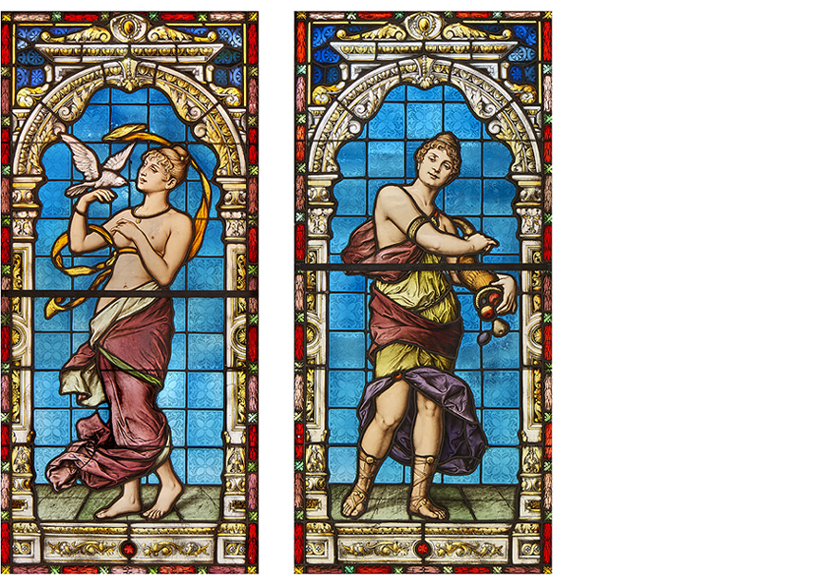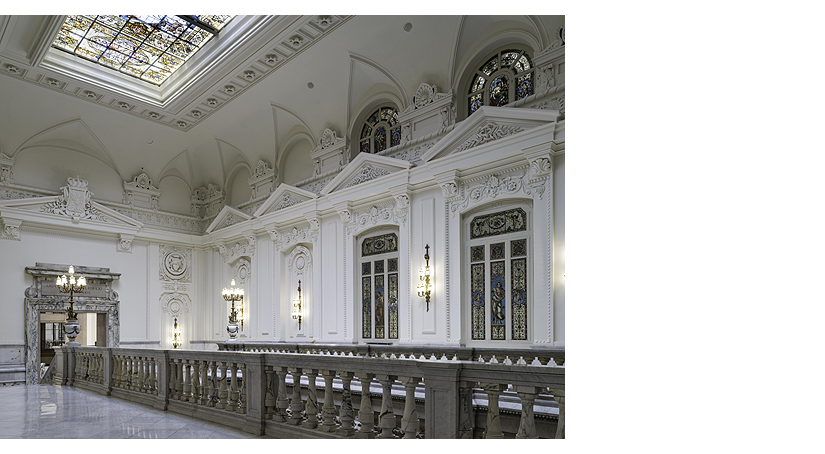
The Imperial Staircase with its symbolist-style stained-glass panels, one of the most iconic parts of our headquarters on Plaza de Cibeles
Along with paintings by artists including Joaquín Sorolla and Carlos Luis de Ribera and a broad selection of images that highlight the important role played by documentary photography in shaping the visual narrative in regard to our headquarters building, the exhibition The Architecture of Eduardo de Adaro and the Banco de España. A Changing World also features various decorative and technology-related objects. These include two fine examples (taken down for the exhibition) of the symbolist-style stained glass panels designed for the building by Mayer of Munich, one of Europe's most prestigious stained-glass workshops in the second half of the 19th century. The company produced numerous works for Spain, which led to its being awarded the Cross of the Royal Order of Isabella the Catholic in 1888.
 Manolo Laguillo. Stained glass by Mayer on the stairwell showing the goddess Fortuna surrounded by the five continents, the Three Graces and the Fates. Series: Adaro: A Case Study (2021). Banco de España Collection
Manolo Laguillo. Stained glass by Mayer on the stairwell showing the goddess Fortuna surrounded by the five continents, the Three Graces and the Fates. Series: Adaro: A Case Study (2021). Banco de España Collection
These panels were installed on various flights of the grand staircase and on the skylight above it, which overlooks the main entrance hall off Paseo del Prado. De Adaro always regarded this hall as being especially important, as evidenced by the many sketches and instructions concerning materials that he provided for it, working with José María Aguilar, one of his closest collaborators. The area was conceived as a single whole, with stained glass panels that bring light and colour to enhance the sense of magnificence and the Carrara marble-work by sculptor Adolfo de Areizaga![]() of Bilbao. It uses the same iconography that can be seen in the rest of the building, though with more direct allusions to the monarchy, including a number of medallions in the form of coins bearing the faces of the kings who supported the creation and development of the bank, from Charles III to Alfonso XIII (though this last medallion must have been altered subsequently, as it bears the date 1905). The sumptuousness of the area, with its ceiling height of 24m, is underscored by the decorative plaster work on the walls, produced by Medardo Sanmartí
of Bilbao. It uses the same iconography that can be seen in the rest of the building, though with more direct allusions to the monarchy, including a number of medallions in the form of coins bearing the faces of the kings who supported the creation and development of the bank, from Charles III to Alfonso XIII (though this last medallion must have been altered subsequently, as it bears the date 1905). The sumptuousness of the area, with its ceiling height of 24m, is underscored by the decorative plaster work on the walls, produced by Medardo Sanmartí![]() . It includes heads of the god Mercury, with his winged helmet, and the goddess Fortuna, with a star in her hair.
. It includes heads of the god Mercury, with his winged helmet, and the goddess Fortuna, with a star in her hair.
 Candida Höfer. Banco de España Staircase Banco de España, Madrid III 2000. Chromogenic print on paper Edition 2/6 Banco de España Collection | Fernando Maquieira. Plaster medallions of the goddess Fortuna and the god Mercury on the main stairwell of the Banco de España. Curatorship Archive of the Banco de España
Candida Höfer. Banco de España Staircase Banco de España, Madrid III 2000. Chromogenic print on paper Edition 2/6 Banco de España Collection | Fernando Maquieira. Plaster medallions of the goddess Fortuna and the god Mercury on the main stairwell of the Banco de España. Curatorship Archive of the Banco de España
Fortuna, the Roman goddess of fortune and the personification of good and bad luck, presides over the great stained glass panel above the stairwell, which also depicts the myth of the abduction of Europa, allegorical figures representing the other four continents and, at its ends, the Three Graces and the Fates. Esperanza Guillén, the joint curator with Yolanda Romero of the exhibition, and author of the book Eduardo Adaro. Arquitecto del Banco de España ['Eduardo Adaro, the Architect of the Banco de España'], published to coincide with its opening, writes that its general appearance 'recalls Illusionist models originating from the Renaissance and later consolidated in the Baroque period, such as a balustrade depicted in perspective that enhances the sense of depth and continuation of the architecture of the building'. The exhibition features a highly detailed colour sketch of this stained-glass panel. There are, however, significant difference between the sketch and the panel as it was eventually constructed. This was commonplace in work of this type, in which the customer might request changes right up to the moment when the 1:1 scale cartoons were completed.
 Preparatory sketch for the stained-glass panel of Fortuna. Mayer’sche Hofkunstanstalt GmbH - Mayer Archives, Munich | Mayer. Stained-glass panel of Fortuna over the main stairwell of the Banco de España. Photo by Fernando Maquieira Curatorship Archive of the Banco de España
Preparatory sketch for the stained-glass panel of Fortuna. Mayer’sche Hofkunstanstalt GmbH - Mayer Archives, Munich | Mayer. Stained-glass panel of Fortuna over the main stairwell of the Banco de España. Photo by Fernando Maquieira Curatorship Archive of the Banco de España
Apart from the skylight there are several more stained-glass panels located along the corridors of the mezzanine, on the main floor and in the round arches of the staircase. They depict scenes that extol the virtues of progress, trade and industriousness, in what can be regarded as an attempt to adapt the classical repertoire of allegories to the image of modernity that the bank sought to project. As mentioned, two of these panels —Cupid and Felicitas— have been removed temporarily from their original settings to form part of the exhibition.
 Mayer Cupid, 1890. Stained glass. Banco de España Collection | Mayer. Felicitas, 1890. Stained glass. Banco de España Collection
Mayer Cupid, 1890. Stained glass. Banco de España Collection | Mayer. Felicitas, 1890. Stained glass. Banco de España Collection
The production of these panels was entrusted to Mayer, a company which had been making stained glass at workshops in Munich since 1862. The order was placed in August 1889, two years before the new headquarters building opened. Walter Uptmoor writes that their design and iconography were probably based on the engravings made by François Ehrmann for the album Le Musée artistique et littéraire, published on the occasion of the Paris Universal Exposition of 1878. The identity of the artist who created the panels was determined from Mayer's archives in the course of the preparatory work for the research project on Eduardo de Adaro of which this exhibition forms part. His name was Martin Ritter von Feuerstein![]() . He was a painter with strong religious convictions (the stained-glass panels at the Banco de España are among the few non-religious works that he produced) who can be regarded as a late-period exponent of the Nazarene movement, though his work incorporates hints of impressionism and art nouveau.
. He was a painter with strong religious convictions (the stained-glass panels at the Banco de España are among the few non-religious works that he produced) who can be regarded as a late-period exponent of the Nazarene movement, though his work incorporates hints of impressionism and art nouveau.
 Manolo Laguillo. Imperial Staircase at the central headquarters of the Banco de España on Plaza de Cibeles in Madrid. Series: Adaro: A Case Study (2021). Banco de España Collection
Manolo Laguillo. Imperial Staircase at the central headquarters of the Banco de España on Plaza de Cibeles in Madrid. Series: Adaro: A Case Study (2021). Banco de España Collection
In much the same way as the use of Carrara marble, the inclusion of the figurative stained-glass panels sought to underscore the fundamental, symbolic role of the grand staircase in the building, in the context of efforts to restore the prestige of craftsmanship in the late 19th century. Indeed, this area can be seen as the most explicit expression of the importance of the bank, and at the same time a way of conveying its values and functions through images. It is also worth noting that the panels had a considerable impact at the time and played a key role, for example, in the proliferation of decorative elements such as candelieri in stained glass installed throughout Spain in the years that followed.
 Manolo Laguillo. The imperial staircase from the rotunda that now connects the 19th century building with the extension designed by Yarnoz. Series: Adaro: A Case Study (2021). Banco de España Collection
Manolo Laguillo. The imperial staircase from the rotunda that now connects the 19th century building with the extension designed by Yarnoz. Series: Adaro: A Case Study (2021). Banco de España Collection
